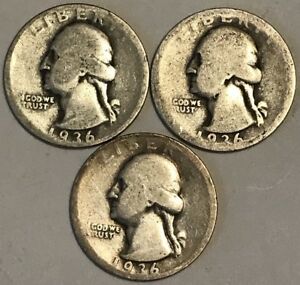The Washington silver quarter is a staple of American coinage that has an interesting history and is one of the most common items for junk silver.
First minted in 1932, the design was introduced to commemorate the 200th birthday of George Washington, the first President of the United States.
The coin was designed by American sculptor and medalist John Flanagan, who’s work was heavily influenced by Augustus St-Gaudens. Flanagan’s design for the Washington quarter became one of the most recognized and longest-running designs in U.S. coinage history. It has appeared on the quarter for over 90 years, with only minor modifications.
The obverse of these silver quarters features the famous left-facing bust of George Washington. On the reverse is the iconic image of the Heraldic Bald Eagle, along with the face value of the coin and country.
Washington Silver Quarter Obverse Inscriptions
- LIBERTY
- IN GOD WE TRUST
- Year date of minting
Washington Silver Quarter Reverse Inscriptions
- UNITED STATES OF AMERICA
- E PLURIBUS UNUM
- QUARTER DOLLAR
Silver Washington Quarters were minted in three US Mint locations.
- The Philadelphia Mint
- The Denver Mint
- The San Francisco Mint
Coins from the Philadelphia Mint bear no mint mark. The Washington quarters from Denver and San Francisco bear the “D” and “S” mint marks.
Stacking Washington Silver Quarters
Junk Silver Quarters are an excellent way to begin investing in Silver. They are extremely liquid and one of the most widely recognizable options for trading and bartering. The premiums over spot price are extremely low, especially when comparing to other fractional silver pieces.
From its introduction in 1932, the Washington quarter was made of 90% silver and 10% copper. Starting in 1965, due to the rising cost of silver, debasement of coinage began and the composition changed to a clad composition of copper-nickel over a pure copper core.
After 1964, the U.S. Mint continued to produce special collector’s edition (proof) Washington quarters with the original 90% silver and 10% copper composition.
The “silver era” of the Washington quarter (1932-1964) is highly sought after by collectors and stackers alike because of its intrinsic value. Each is minted from an alloy of 90% silver and 10% copper. The approximate silver weight of each silver quarter is roughly .179 troy ounces.
A standard shotgun bank roll of Washington Silver Quarters contains 40 coins. Forty silver quarters is the equivalent of $10 Face Value. Each bank roll of silver quarters contains roughly 7.15 troy ounces of silver. For uncirculated Washington Quarters, the silver content may be slightly higher.
The 1932-D (Denver mint) and 1932-S (San Francisco mint) are the key dates for the series due to their low mintages. They are the most sought-after and valuable Washington silver quarters for collectors.
The Washington quarter replaced the Standing Liberty quarter, which was minted from 1916 to 1930.
Collecting silver quarters offers a glimpse into America’s numismatic history, and each is also a tangible connection to the nation’s past. Whether for the silver content or their historical significance, these coins remain popular among both collectors and stackers.
How Can You Easily Spot a Silver Washington Quarter?
There are several simple and easy ways to determine if a Washington Quarter is of the variety that were minted with 90% silver content. The things to look for when identifying silver quarters are:
- The mintage year. Washington Quarters that are dated earlier than 1964 were minted with 90% silver content.
- Silver quarters have a slightly different color than clad quarters made after 1964. While checking the date is the first important clue, the luster of a circulated silver quarter is different.
- The edge of the quarter will be silver all the way through. Clad quarters have a core made from copper which is evident along the edge of the coin. Silver Washington quarters will show a completely silver edge.
